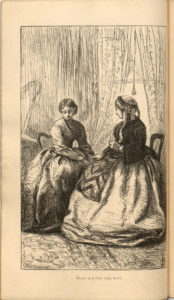Maid
A maid in the 19th century demonstrated the wealth of a family. If a family was of high status than a maid would be incorporated as a member. The work that the mistress could not get done at home is the one the maid would take over and get done. The maid in the novella New Year’s Day, played a role to demonstrate how women would do house work while men or woman of a family could not.

Trollope Anthony. “Orely Farm.” British Library, London 1862. https://www.bl.uk/romantics-and-victorians/articles/mrs-beeton-and-the-art-of-household-management
Isabella Beeton in 1861 published a book “Mrs.Beeton: Duties of a Lady-Maid” explaining the jobs to a maid and what was expected of her. This text helps explain a maid’s job but also the role of a maid in the Hazeldean family.
Besides a maid being a part of the family to cook, clean, and act as a servant, she was also the woman’s dresser. A maid would need to align clothing for the woman of the house and act as a hair dresser. This is important to notice because a woman of a high status was not able to do this herself, she needed a maid to get this done. What we see here is that not only men threw down the image of a woman by making her do a maid’s labor, but we also have women who lived-in high-status families who also needed another woman’s assistance in order to get herself ready or prepare herself properly with the right clothes.
Another label for a maid would be a “waiting-maid,” which is the closet to the maid the Hazeldean family had. A waiting maid was one who would make herself useful in being around the mistress to give her, her own opinion when she needed one, or to have someone to talk to. This maid is the one which can be seen as closest to the family because she can be considered another member because she gets to conversate with the family.
“A waiting-maid who wishes to make herself useful, will study the fashion-books with attention, so as to be able to id her mistress’s judgement in dressing, according to the prevailing fashion, with such modifications as her style of countenance requires. She will also, if she has her mistress’s interest at heart, employ her spare time in repairing and making up dresses which have served one purpose, to serve another also; or turning many things, unlifted for her mistress to use, for the younger branches of the family. The lady’s-maid may thus render herself invaluable to her mistress, and increase her own happiness in so doing.” (Beeton).
As you can see, a waiting-maid was one who was much closer to the mistress and would do anything to please her. In this case the maid in the Hazeldean family had a good relationship with Lizzie Hazeldean and her husband being able to speak to her and have her give them some sort of advice. This plays a role when Lizzie comes back from the Fifth Avenue Hotel and finds out that the family maid allowed and advised Mr. Hazeldean to go out. In the reading it is stated. “Mistress and maid exchanged a glance of sympathy, and Susan felt herself emboldened to suggest: “Perhaps the outgoing will do him good,” with the tendency of her class to encourage favoured invalids in disobedience. Mrs.Hazeldean’s look grew severe. ‘Susan! I’ve often warned you against talking to him in that way—’” (250). Lizzie becomes upset to this because this is what can lead her affair to be known about. She is indeed mad that the maid favored Mr. Hazeldean in letting him take a walk when she could have been discovered.
https://www.youtube.com/watch?v=pJO8Oe6hJp8
Beeton, Isabella Mary. The Book of Household Management, etc. London: 1861. British Library. < http://www.bl.uk/learning/timeline/item106397.html>



[…] and maid exchanged a glance of sympathy, and Susan felt herself emboldened to suggest: “Perhaps the […]